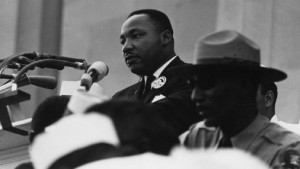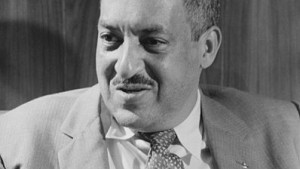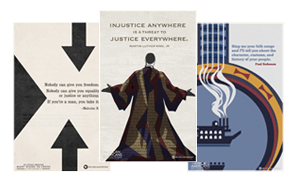Episode Five: Rise! The Road to Civil Rights
The Road to Civil Rights
Rise! examines the long road to civil rights, when the deep contradictions in American society finally became unsustainable. Beginning in World War II, African Americans who helped fight fascism abroad came home to face the same old racial violence. But this time, mass media — from print to radio and TV — broadcast that injustice to the world, planting seeds of resistance. And the success of black entrepreneurs and entertainers fueled African-American hopes and dreams.
In December 1955, Rosa Parks refused to give up her seat to a white man on a city bus in Montgomery, Alabama, heralding the dawn of a new movement of quiet resistance, with the Reverend Dr. Martin Luther King, Jr. as its public face. Before long, masses of African Americans practiced this nonviolent approach at great personal risk to integrate public schools, lunch counters and more. Even children became public figures in the struggle, such as six-year-old Ruby Bridges, who integrated an all-white school in New Orleans in 1960 and four years later was depicted in a Norman Rockwell painting. As the civil rights movement scored one historic victory after another, non-violence was still all too often met with violence — until finally, enough was enough. By 1968, Dr. King, the apostle of non-violence, would be assassinated, unleashing a new call for “Black Power” across the country.
Rise! is episode five of the six-part series, The African Americans: Many Rivers to Cross with Henry Louis Gates, Jr. Episode five premieres on PBS on November 19, 2013, 8-9 pm ET. Check local listings on the broadcast schedule.
The Road to Civil Rights
Rise! examines the long road to civil rights, when the deep contradictions in American society finally became unsustainable. Beginning in World War II, African Americans who helped fight fascism abroad came home to face the same old racial violence. But this time, mass media — from print to radio and TV — broadcast that injustice to the world, planting seeds of resistance. And the success of black entrepreneurs and entertainers fueled African-American hopes and dreams.
In December 1955, Rosa Parks refused to give up her seat to a white man on a city bus in Montgomery, Alabama, heralding the dawn of a new movement of quiet resistance, with the Reverend Dr. Martin Luther King, Jr. as its public face. Before long, masses of African Americans practiced this nonviolent approach at great personal risk to integrate public schools, lunch counters and more. Even children became public figures in the struggle, such as six-year-old Ruby Bridges, who integrated an all-white school in New Orleans in 1960 and four years later was depicted in a Norman Rockwell painting. As the civil rights movement scored one historic victory after another, non-violence was still all too often met with violence — until finally, enough was enough. By 1968, Dr. King, the apostle of non-violence, would be assassinated, unleashing a new call for “Black Power” across the country.
Rise! is episode five of the six-part series, The African Americans: Many Rivers to Cross with Henry Louis Gates, Jr. Episode five premieres on PBS on November 19, 2013, 8-9 pm ET. Check local listings on the broadcast schedule.
Find educational resources related to this program - and access to thousands of curriculum-targeted digital resources for the classroom at PBS LearningMedia.
Visit PBS Learning Media










